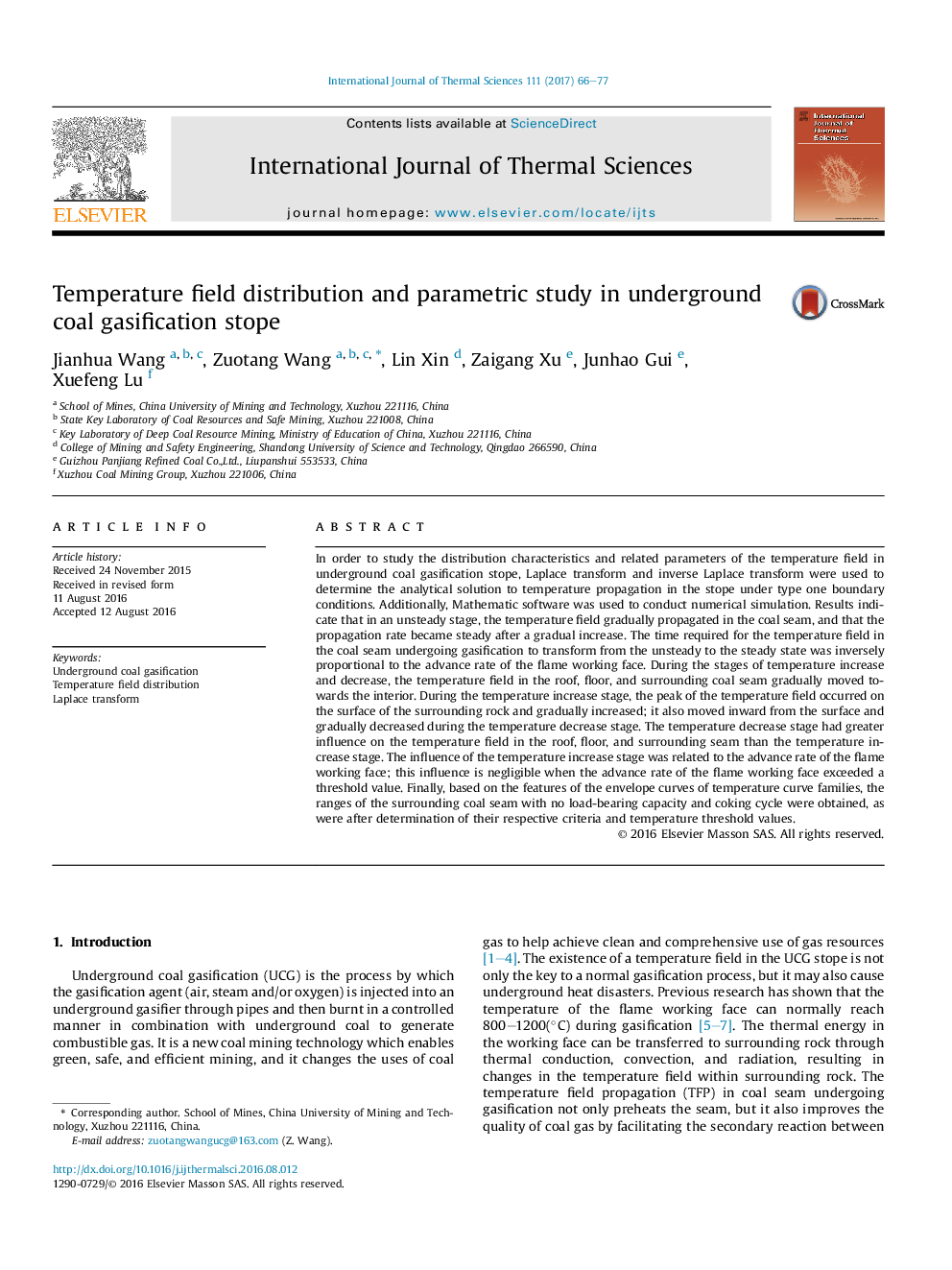| کد مقاله | کد نشریه | سال انتشار | مقاله انگلیسی | نسخه تمام متن |
|---|---|---|---|---|
| 667917 | 1458711 | 2017 | 12 صفحه PDF | دانلود رایگان |
عنوان انگلیسی مقاله ISI
Temperature field distribution and parametric study in underground coal gasification stope
ترجمه فارسی عنوان
توزیع دما و توزیع پارامتری در زهاب گاز زیرزمینی
دانلود مقاله + سفارش ترجمه
دانلود مقاله ISI انگلیسی
رایگان برای ایرانیان
کلمات کلیدی
گازسوز زغال سنگ، توزیع میدان دما، تبدیل لاپلاس،
ترجمه چکیده
به منظور بررسی ویژگی های توزیع و پارامترهای مربوط به دمای دما در گرمایش گازسوز زیرزمینی، تبدیل لاپلاس و تبدیل لپلاس معکوس برای تعیین راه حل تحلیلی برای انتشار دما در سقف در شرایط مرزی 1 نوع استفاده شد. علاوه بر این، نرم افزار ریاضی برای انجام شبیه سازی عددی استفاده شد. نتایج نشان می دهد که در یک مرحله ناپایدار، درجه حرارت به تدریج در جوش زغال سنگ پخش می شود و پس از افزایش تدریجی میزان انتشار ثابت می شود. زمان مورد نیاز برای میدان دما در جوش ذغال سنگ تحت گازسیون برای تبدیل از ناپایدار به حالت پایدار به طور معکوس متناسب با نرخ پیشرفت چهره کار شعله است. در طول مراحل افزایش و کاهش درجه حرارت، درجه حرارت در سقف، کف و درز زغال سنگ اطراف به تدریج به سمت داخل حرکت کرد. در طول مرحله افزایش دما، اوج درجه حرارت روی سطح سنگ اطراف رخ می دهد و به تدریج افزایش می یابد؛ آن نیز از داخل به داخل حرکت می کند و در مرحله کاهش دمای به تدریج کاهش می یابد. مرحله کاهش دما تاثیر بیشتری بر میدان دما در سقف، کف و دریای اطراف نسبت به مرحله افزایش دما داشت. تاثیر مرحله افزایش دما به میزان پیشرفت چهره کاری شعله مربوط می شود؛ این نفوذ ناچیز است زمانی که نرخ پیشروی صورت شلیک شعله بیش از مقدار آستانه است. در نهایت، با توجه به ویژگی های منحنی پاکت از خانواده های منحنی دما، محدوده های جوش زغال سنگ اطراف بدون ظرفیت باربری و چرخه کوکسیون به دست آمده، همانطور که بعد از تعیین معیارهای مربوطه و مقادیر آستانه دما، به دست آمد.
موضوعات مرتبط
مهندسی و علوم پایه
مهندسی شیمی
جریان سیال و فرایندهای انتقال
چکیده انگلیسی
In order to study the distribution characteristics and related parameters of the temperature field in underground coal gasification stope, Laplace transform and inverse Laplace transform were used to determine the analytical solution to temperature propagation in the stope under type one boundary conditions. Additionally, Mathematic software was used to conduct numerical simulation. Results indicate that in an unsteady stage, the temperature field gradually propagated in the coal seam, and that the propagation rate became steady after a gradual increase. The time required for the temperature field in the coal seam undergoing gasification to transform from the unsteady to the steady state was inversely proportional to the advance rate of the flame working face. During the stages of temperature increase and decrease, the temperature field in the roof, floor, and surrounding coal seam gradually moved towards the interior. During the temperature increase stage, the peak of the temperature field occurred on the surface of the surrounding rock and gradually increased; it also moved inward from the surface and gradually decreased during the temperature decrease stage. The temperature decrease stage had greater influence on the temperature field in the roof, floor, and surrounding seam than the temperature increase stage. The influence of the temperature increase stage was related to the advance rate of the flame working face; this influence is negligible when the advance rate of the flame working face exceeded a threshold value. Finally, based on the features of the envelope curves of temperature curve families, the ranges of the surrounding coal seam with no load-bearing capacity and coking cycle were obtained, as were after determination of their respective criteria and temperature threshold values.
ناشر
Database: Elsevier - ScienceDirect (ساینس دایرکت)
Journal: International Journal of Thermal Sciences - Volume 111, January 2017, Pages 66-77
Journal: International Journal of Thermal Sciences - Volume 111, January 2017, Pages 66-77
نویسندگان
Jianhua Wang, Zuotang Wang, Lin Xin, Zaigang Xu, Junhao Gui, Xuefeng Lu,
